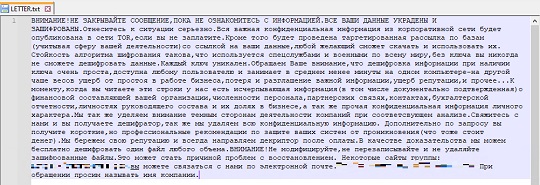Ransom.Win32.WERWOLVES.THAAOBD
Ransom:Win32/Conti.AD!MTB (MICROSOFT)
Windows


Threat Type: Ransomware
Destructiveness: No
Encrypted: Yes
In the wild: Yes
OVERVIEW
This Ransomware arrives on a system as a file dropped by other malware or as a file downloaded unknowingly by users when visiting malicious sites.
It drops files as ransom note.
TECHNICAL DETAILS
Arrival Details
This Ransomware arrives on a system as a file dropped by other malware or as a file downloaded unknowingly by users when visiting malicious sites.
Installation
This Ransomware drops the following files:
- %System Root%\CONTI_LOG.txt → If -log enabled is used
(Note: %System Root% is the Windows root folder, where it usually is C:\ on all Windows operating system versions.)
It adds the following processes:
- cmd.exe /c %System%\wbem\WMIC.exe shadowcopy where "ID='{Shadow Copy ID}'" delete → It will repeat this process depending on the number of shadow copies.
(Note: %System% is the Windows system folder, where it usually is C:\Windows\System32 on all Windows operating system versions.)
It adds the following mutexes to ensure that only one of its copies runs at any one time:
- kjsidugidf99439
Other Details
This Ransomware does the following:
- When encrypting network shares it will check if the IP address starts with the following to ensure that it is encrypting local, non-internet, systems:
- 172.
- 192.168.
- 10.
- 169.
- By default, it encrypts local drives, removable drives and network shares.
- It looks for database storage files by looking for the following strings in their file path:
- .4dd
- .4dl
- .accdb
- .accdc
- .accde
- .accdr
- .accdt
- .accft
- .adb
- .ade
- .adf
- .adp
- .arc
- .ora
- .alf
- .ask
- .btr
- .bdf
- .cat
- .cdb
- .ckp
- .cma
- .cpd
- .dacpac
- .dad
- .dadiagrams
- .daschema
- .db
- .db-shm
- .db-wal
- .db3
- .dbc
- .dbf
- .dbs
- .dbt
- .dbv
- .dbx
- .dcb
- .dct
- .dcx
- .ddl
- .dlis
- .dp1
- .dqy
- .dsk
- .dsn
- .dtsx
- .dxl
- .eco
- .ecx
- .edb
- .epim
- .exb
- .fcd
- .fdb
- .fic
- .fmp
- .fmp12
- .fmpsl
- .fol
- .fp3
- .fp4
- .fp5
- .fp7
- .fpt
- .frm
- .gdb
- .grdb
- .gwi
- .hdb
- .his
- .ib
- .idb
- .ihx
- .itdb
- .itw
- .jet
- .jtx
- .kdb
- .kexi
- .kexic
- .kexis
- .lgc
- .lwx
- .maf
- .maq
- .mar
- .mas
- .mav
- .mdb
- .mdf
- .mpd
- .mrg
- .mud
- .mwb
- .myd
- .ndf
- .nnt
- .nrmlib
- .ns2
- .ns3
- .ns4
- .nsf
- .nv
- .nv2
- .nwdb
- .nyf
- .odb
- .oqy
- .orx
- .owc
- .p96
- .p97
- .pan
- .pdb
- .pdm
- .pnz
- .qry
- .qvd
- .rbf
- .rctd
- .rod
- .rodx
- .rpd
- .rsd
- .sas7bdat
- .sbf
- .scx
- .sdb
- .sdc
- .sdf
- .sis
- .spg
- .sql
- .sqlite
- .sqlite3
- .sqlitedb
- .te
- .temx
- .tmd
- .tps
- .trc
- .trm
- .udb
- .udl
- .usr
- .v12
- .vis
- .vpd
- .vvv
- .wdb
- .wdmb
- .wrk
- .xdb
- .xld
- .xmlff
- .abcddb
- .abs
- .abx
- .accdw
- .adn
- .db2
- .fm5
- .hjt
- .icg
- .icr
- .kdb
- .lut
- .maw
- .mdn
- .mdt
- It looks for disk image files by looking for the following file extensions in their file path:
- .vdi
- .vhd
- .vmdk
- .pvm
- .vmem
- .vmsn
- .vmsd
- .nvram
- .vmx
- .raw
- .qcow2
- .subvol
- .bin
- .vsv
- .avhd
- .vmrs
- .vhdx
- .avdx
- .vmcx
- .iso
It accepts the following parameters:
- -h - {txtfile containing list of hosts to encrypt}
- -p - {txtfile containing list of folders to encrypt first before proceeding to the other folders}
- -m - {all|local|net|backups}
- all - combination of net and local
- local - delete backups and encrypt local drives
- net - delete backups and encrypt only network shares
- backups - delete backups
- -log enabled - log output to %System Root%\CONTI_LOG.txt
(Note: %System Root% is the Windows root folder, where it usually is C:\ on all Windows operating system versions.)
Ransomware Routine
This Ransomware avoids encrypting files with the following strings in their file name:
- .crypt
- .exe
- .dll
- .lnk
- .sys
- .msi
- LETTER.txt
- CONTI_LOG.txt
It avoids encrypting files with the following strings in their file path:
- tmp
- winnt
- temp
- thumb
- $Recycle.Bin
- $RECYCLE.BIN
- System Volume Information
- Boot
- Windows
- Trend Micro
It appends the following extension to the file name of the encrypted files:
- .crypt
It drops the following file(s) as ransom note:
- {Encrypted Folder}\LETTER.txt

SOLUTION
Step 1
Before doing any scans, Windows 7, Windows 8, Windows 8.1, and Windows 10 users must disable System Restore to allow full scanning of their computers.
Step 2
Note that not all files, folders, and registry keys and entries are installed on your computer during this malware's/spyware's/grayware's execution. This may be due to incomplete installation or other operating system conditions. If you do not find the same files/folders/registry information, please proceed to the next step.
Step 3
Search and delete these files
- {Encrypted Folder}\LETTER.txt
- %System Root%\CONTI_LOG.txt
Step 4
Scan your computer with your Trend Micro product to delete files detected as Ransom.Win32.WERWOLVES.THAAOBD. If the detected files have already been cleaned, deleted, or quarantined by your Trend Micro product, no further step is required. You may opt to simply delete the quarantined files. Please check the following Trend Micro Support pages for more information:
Step 5
Restore encrypted files from backup.
Did this description help? Tell us how we did.

